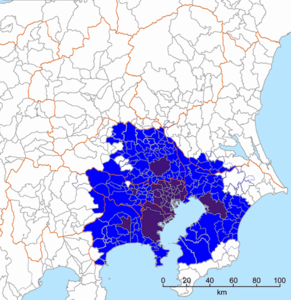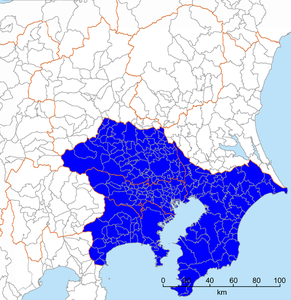Tokyo Metropolitan Area
The metropolitan area of Tokyo covers an area of 14,034 square kilometers on the Japanese Pacific coast and forms the economic, political and cultural center of the country. Japanese names for it are Tōkyōken ( 東京 圏 ; dt. About "Tokyo area"), Shutoken ( 首都 d ; dt. About "capital area"), Itto Sanken ( 一 都 三 県 ; dt. About "one metropolis, three prefectures" ) or Minami- Kantō ( 南 関 東 ; dt. about "Süd-Kanto"), which are not synonymous, as well as in English Greater Tokyo Area , Keihinyo Major Metropolitan Area or simply Tokyo-Yokohama .
With 36.9 million inhabitants (2015) it is the largest metropolitan region in the world . The four metropolises of Tokyo (or the 23 districts ), Yokohama , Kawasaki , Saitama , as well as Chiba and Sagamihara form the core cities. The region consists of the four prefectures Tokyo , Kanagawa , Saitama and Chiba , but has recently expanded into the Ibaraki prefecture .
The metropolitan region has grown rapidly since the middle of the 20th century, both in terms of area and population. About 29 percent of the total population of Japan live in it. Its outer limit is about 70 kilometers from Tokyo city center. In contrast, the population of Tokyo's 23 boroughs has decreased since 1965 , but has been increasing again since 1995 due to reurbanization .
Definition variants
Different sources draw the boundary for the metropolitan area in different ways. Depending on the definition, the population varies between 30 and 40 million. For economic statistics, the University of Tokyo has defined a “capital city employment area” made up of areas with a high proportion of commuters. Other definitions such as the Kantō region or the “capital area” encompass multiple prefectures as a whole.
- Different definitions of the Tokyo region
Tokyo Prefecture excluding Izu and Ogasawara Islands (13.5 million inhabitants, 2015)
Toshi Koyōken ( 都市 雇用 圏 , German "Capital Employment Area "; 35.3 million inhabitants, 2015) of the University of Tokyo
See also
Individual evidence
- ↑ a b Statistical Handbook of Japan 2015. 6. Population Density and Regional Distribution. Japanese Statistical Office, accessed July 15, 2016 .
- ↑ Demographia World Urban Areas (Built-Up Urban Areas or World Agglomerations) 12th annual Edition April 2016







